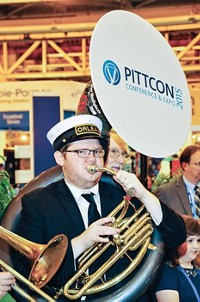Advertisement
Grab your lab coat. Let's get started
Welcome!
Welcome!
Create an account below to get 6 C&EN articles per month, receive newsletters and more - all free.
It seems this is your first time logging in online. Please enter the following information to continue.
As an ACS member you automatically get access to this site. All we need is few more details to create your reading experience.
Not you? Sign in with a different account.
Not you? Sign in with a different account.
ERROR 1
ERROR 1
ERROR 2
ERROR 2
ERROR 2
ERROR 2
ERROR 2
Password and Confirm password must match.
If you have an ACS member number, please enter it here so we can link this account to your membership. (optional)
ERROR 2
ACS values your privacy. By submitting your information, you are gaining access to C&EN and subscribing to our weekly newsletter. We use the information you provide to make your reading experience better, and we will never sell your data to third party members.
Environment
Pittcon Roundup
by A. Maureen Rouhi
April 2, 2012
| A version of this story appeared in
Volume 90, Issue 14
Pittcon is a signature event for the instrumentation and analytical chemistry communities. C&EN’s comprehensive coverage of Pittcon 2012 begins on page 32, reported by Senior Editor Celia Arnaud, Deputy Assistant Managing Editor Stu Borman, and Senior Correspondent Marc Reisch.
Despite some questions about the exhibition (C&EN, March 19, page 3), Pittcon offers not only a terrific overview of the breadth of instrumentation innovations and offerings, but also historical perspective in the form of the annual Pittcon Heritage Award. I attended the meeting’s plenary lecture and was delighted with the accessibility of the lecturer’s talk. Most of all, I enjoyed the conversations with visitors at C&EN’s booth.
The opening session featured the presentation of the first-ever posthumous Pittcon Heritage Award, to Genzo Shimadzu Sr. and Jr., father and son founders of the Japanese instrumentation company that bears their name. Shimadzu Chairman of the Board Shigehiko Hattori accepted the award from Chemical Heritage Foundation President and CEO Thomas R. Tritton and Pittcon President Jon Peace.
Genzo Sr. was a maker of Buddhist altars before he became an inventor of instruments. When Western powers forced Japan to open its ports to international trade in 1868, the nation also opened its eyes to Western technology. At the Physics & Chemistry Research Institute in Kyoto, the elder Shimadzu learned to repair and maintain foreign equipment. In 1875, he began manufacturing distillation and other devices for use in Japanese schools. After Genzo Sr. died in 1894, control of the business went to his eldest son, Umejiro, who changed his name to Genzo.
With his younger brothers, Genzo Jr. took the business in new directions, notably storage batteries and X-ray equipment. Today, Shimadzu offers diverse products, from analytical and measuring instruments to aircraft and industrial equipment.
In the plenary lecture, R. Graham Cooks, Henry B. Hass Distinguished Professor of Analytical Chemistry at Purdue University, shared his vision: the mass spectrometer as a people’s instrument, based on the premise that everyone could have a reason to use a mass spectrometer. To make the point, he showed a video of two people in a supermarket with a portable mass spectrometer. They took an orange purported to be “organic.” On-the-spot analysis showed that the skin contains thiabendazole, a pesticide applied to oranges after harvest to prevent fungal growth. “Not organic,” Cooks declared.
“We have a lot of measurements to make,” Cooks said, but most instruments are geared for high-end analysis. For the “billions of items of commerce, food, medicine, and household items,” he said, “we also need to develop less capable instruments that can make lots and lots of measurements with adequate analytical performance.”
At the C&EN booth, I asked those who said they read C&EN, “How are we doing?” The answers varied from good to great. “I joined the American Chemical Society to get C&EN,” offered one visitor.
James Bellows, an engineer at Siemens Energy, in Orlando, came by especially to thank C&EN for being his “lifeline to the chemistry world.” Bellows works in the steam turbine department at Siemens’ energy sector headquarters for the Americas. His job is to keep impurities in the steam at only 4 x 10-7 M to avoid corrosion. Above approximately 10 parts per quadrillion, he says, salts can deposit on the turbines, leading to corrosion. But a few parts per billion is a practical, effective limit; at higher concentrations, salts and oxides can become thick deposits on the turbine, causing capacity to drop. “A 2% capacity loss gets people very excited,” he said, because downtime from his turbines can cost up to $250,000 to $1 million per day.
Bellows is the lone chemist among hundreds of mechanical and electrical engineers at his location. “I think about chemistry in everything,” he said, and C&EN “keeps me up-to-date.” For topics familiar to Bellows, he said, C&EN “has it right. That gives me confidence that all the reporting is good quality.” Thanks for the feedback, Jim.





Join the conversation
Contact the reporter
Submit a Letter to the Editor for publication
Engage with us on Twitter